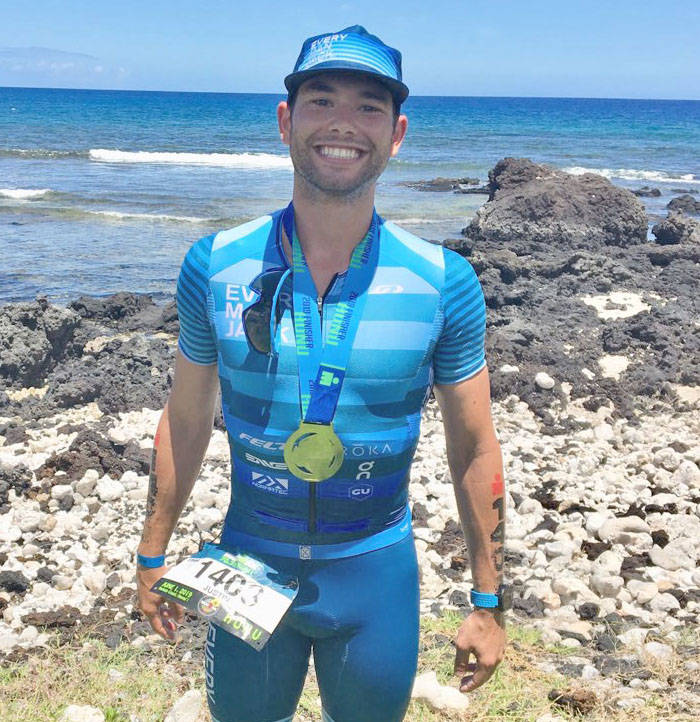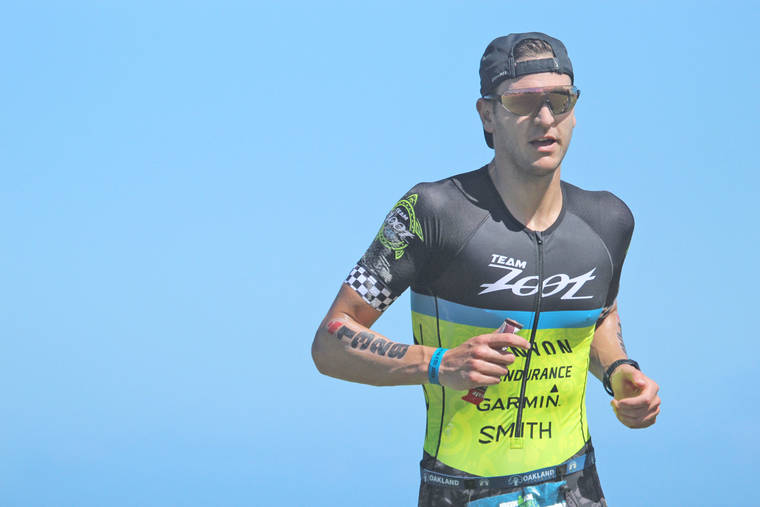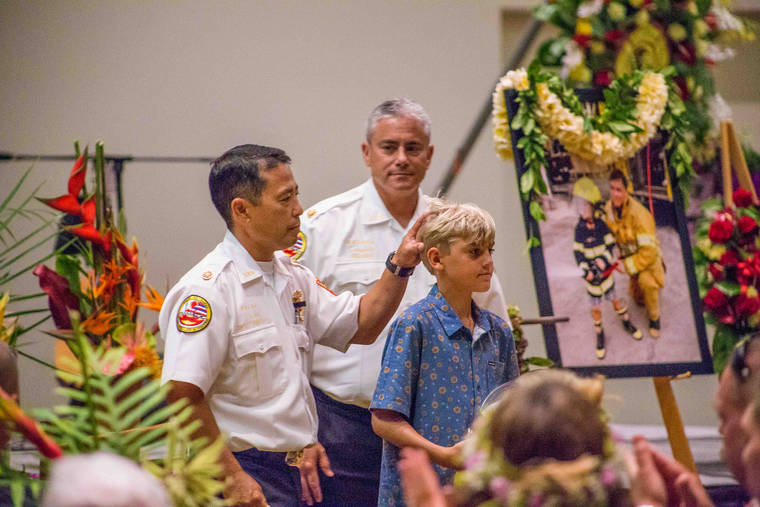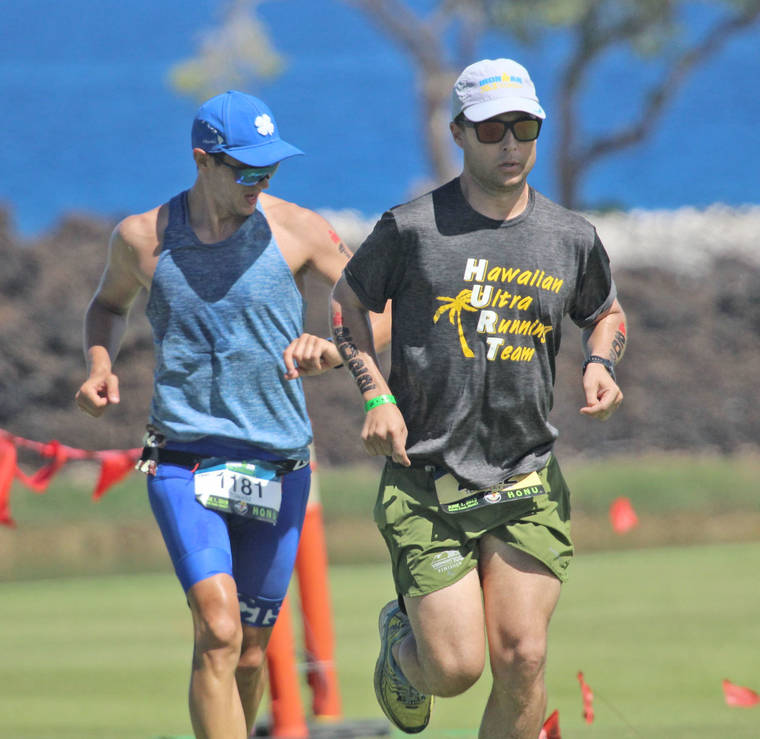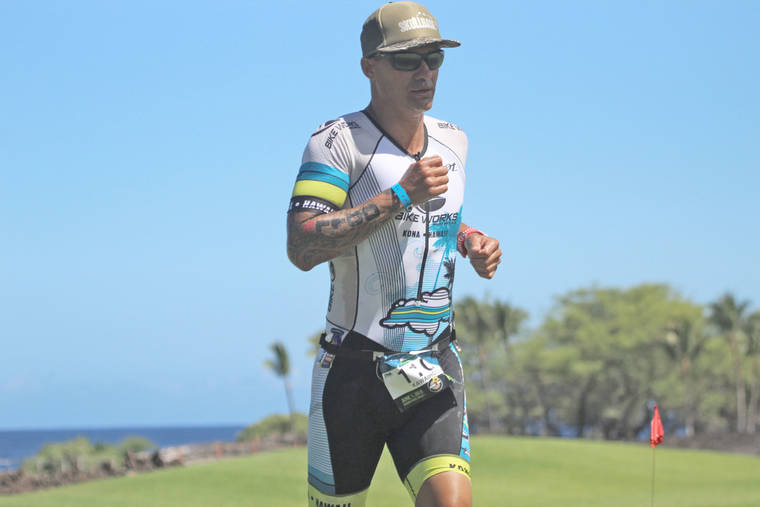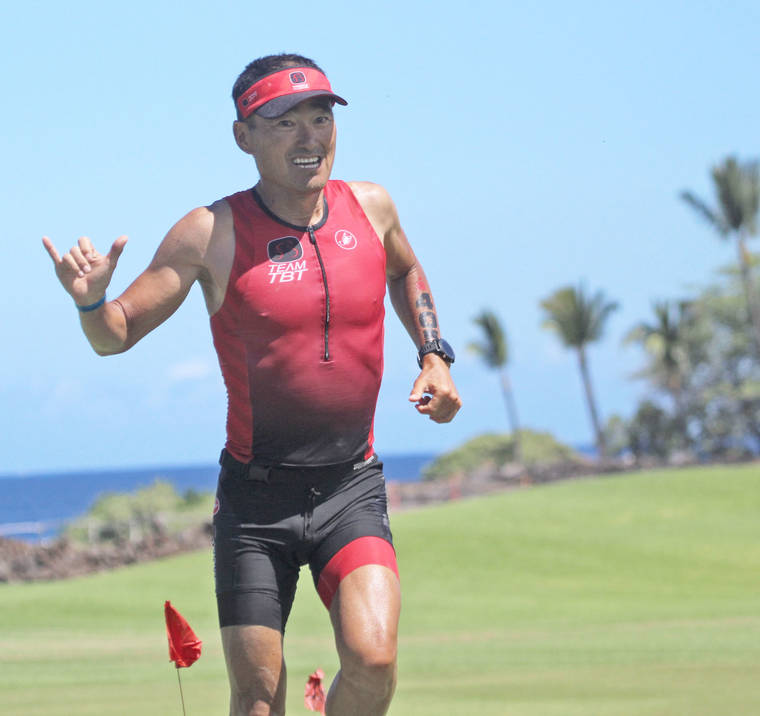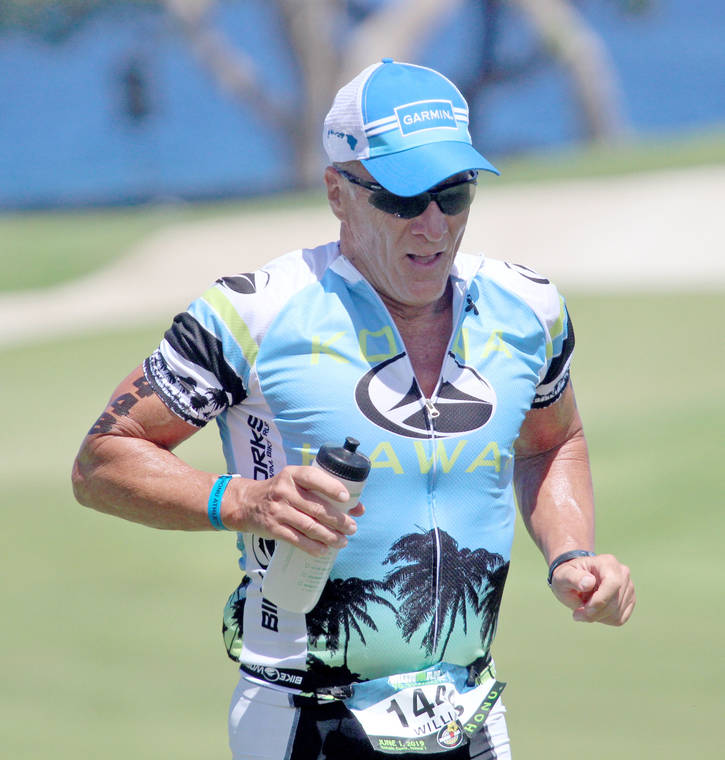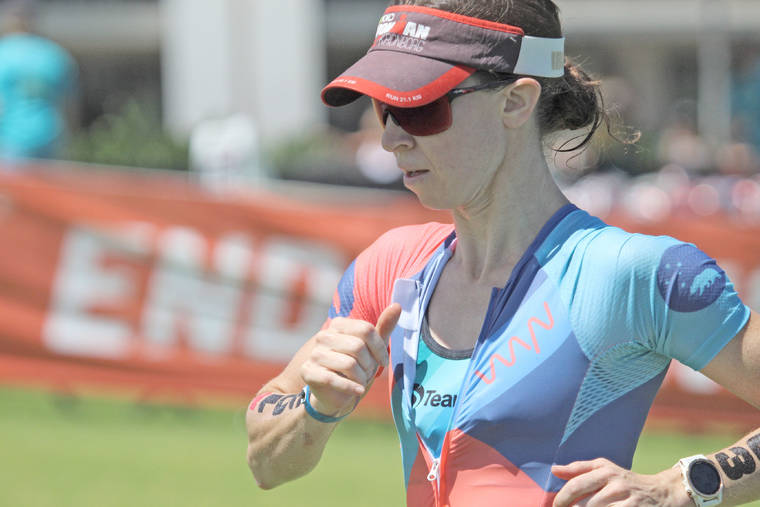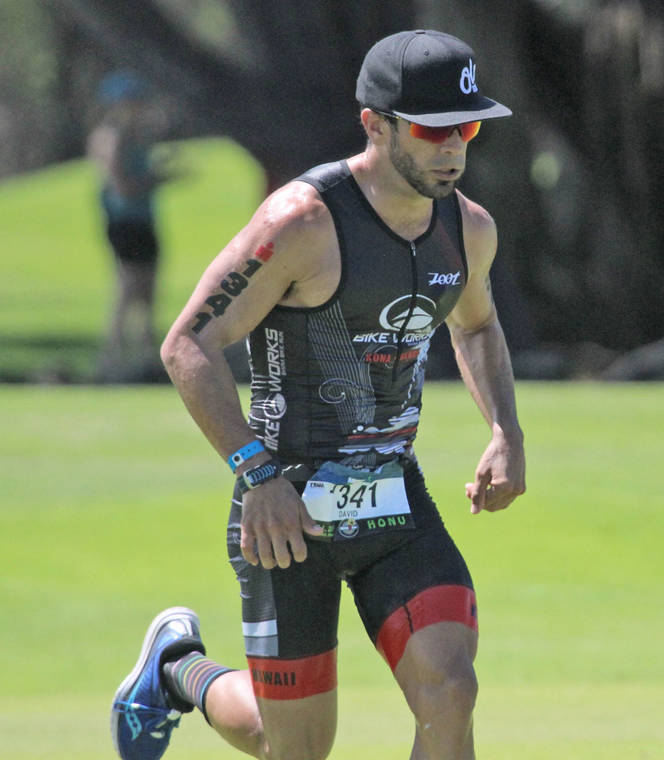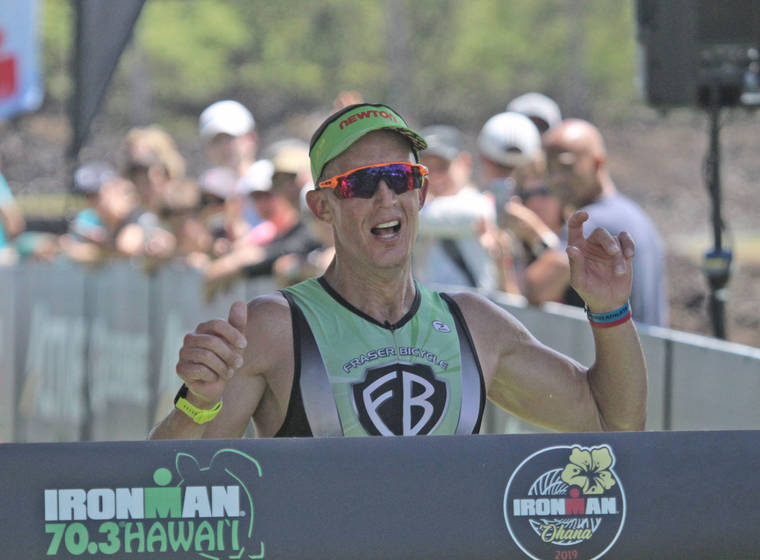Justin Riele has record-setting day, takes top overall honors at a speedy Ironman 70.3 Hawaii
KOHALA COAST When Justin Riele spotted a sea turtle cruising below the surface at Hapuna midway through the swim at the Ironman 70.3 Hawaii on Saturday morning, he knew it was a good omen.
KOHALA COAST — When Justin Riele spotted a sea turtle cruising below the surface at Hapuna midway through the swim at the Ironman 70.3 Hawaii on Saturday morning, he knew it was a good omen.
It turned out to be that — and a little more — for Riele’s record-setting race on the Big Island.
Propelled by the fastest bike of the day, Riele took home the top overall honors at the half-Ironman event — also known as Honu — completing the 1.2-mile swim, 56-mile bike and 13.1-mile run in 4 hours, 14 minutes and 34 seconds.
“It’s not every day you get to see a turtle during the swim” Riele said, who set a personal record by almost eight minutes. “Best racing day of my triathlon career so far, for sure. I’m still pretty shocked. Heck of a day.”
Riele’s time was the fastest at the race since it moved to an age-group exclusive event in 2015, eliminating the pro field. Tim Rea’s mark of 4:18:33 in 2016 was the previous best.
“I like this distance and love this course,” Riele said. “You can really lay it all out on the line.”
Riele — who’s 25 years old and based out of San Francisco — is relatively new to the sport, picking it up just two years ago. He recently started working with a coach and joined the Every Man Jack triathlon team, both of which he said were factors for his stellar showing.
“It’s been a huge motivator for me,” he said. “I think the PR showed that the hard work is paying off.”
Riele’s bike was the highlight of the day, battling through some headwind during the ride to Hawi on the northern half of the Ironman World Championship course.
“I knew if I biked my way into the race I would be in the overall running,” Riele said. “My dad told me at around Mile 12 of the run I had a shot, and I just let it rip.”
Nearly 1,200 athletes completed the race, which serves as a qualifier for both the Ironman 70.3 World Championship in Nice, France and the Ironman World Championship, held annually in Kona. There were a total of 94 slots available — 40 for the 70.3 worlds, and 54 slots for Kona, 24 reserved exclusively for Hawaii residents who finish as the top Aloha State athlete in their age group.
Riele had already earned a spot in France for the 70.3 championship in September, but thanks to the win, he can book a return ticket to the Big Island for the vaunted Kona World Championship race.
“That will be my first full Ironman,” Riele said. “I don’t think a lot of people can say that about Kona. Hopefully I don’t melt on the marathon.”
As it did last year, the event utilized a rolling swim start within the age groups, with a buzzer every five seconds signaling the athletes — who self-seeded based on perceived finishing time — to enter the water.
It’s proven effective to increase safety, reduce anxiety and allow athletes to swim at their own pace. It also opens up the bike segment of the race, reducing drafting.
But it also adds extra anxiety around the finish line, because the first athlete to the finish line isn’t necessarily the top overall finisher, which is usually celebrated by breaking through a banner, among other things.
Daniel Stubleski was the first to the Fairmont Orchid’s Honu Pointe, busting through the finishing tape with a time of 4:17:06. He did not have any company for quite some time and he had reason to be comfortable with a maile lei around his neck. His finish also had broken the barrier as the fastest since 2015.
However, Stubleski started in the first wave of the day (male 40-44), 25 minutes ahead of Riele, relegating him to second overall. He still won his age-group by almost 10 minutes, edging out John Newsom, a New Zealand athlete who finished seventh overall and won the race back in 2017.
Stubleski was in good spirits post-race.
“How can you not like this race? It’s amazing,” he said, looking at the ocean behind him. “I wanted to swim as fast as I could, bike as fast as I could and then have enough room on the run. The run is what I’m most proud of from this race.”
Much of the run takes place on the Francis H. I’i Brown golf course, which Stubleski — who will race in his seventh Ironman World Championship in October — noted as a scenic route.
“It’s the first time I’ve run on a golf course,” Stubleski said. “It’s so nice. You can just look around and take your mind off running.”
Rounding out the top three overall on the male side was California’s Brian Mancini (4:21:31).
In the women’s race, South Africa’s Natia Van Heerden took home the overall title with a time of 4:50:20. She edged Oahu’s Carly Killam, who notched her second consecutive runner-up finish with a time of 4:52:24.
Killam faced a similar situation to Stubleski, being first to the finish line but settling for second.
“That’s the thing about this race,” Killam said with a smile. “You never know.”
However, Killam did earn a Kona spot thanks to her stellar time — her second consecutive.
Sarah Cameto was the third overall female finisher, clocking a time of 4:55:58.
Wild goes flat, finishes strong
David Wild made no secret about his goals heading into Honu. He wanted to win. And not just his age group, or among Big Islanders — he wanted to win the whole thing.
“That’s what I wanted to do,” Wild said. “I had high hopes and felt really good coming in. No injuries or anything and I was sleeping good all week.”
Wild had reason to believe he could do it. He finished in the top 10 overall in all four of his previous tries at Honu, making it into the top five twice. He recently won his first Lavaman Waikoloa — an Olympic idstance triathlon — in March and the stars seemed to be aligning for Wild to reel in another landmark victory.
Wild, a math teach at Konawaena High School, even took the final day off of school to prepare for the race — something that wasn’t easy for him to do.
“It’s super sad,” he said. “I’m going to miss all those kids, but I knew I had to do it to stay focused.”
Wild got the start he wanted to give himself a shot, but around Mile 20 his plans hit a snag. He got a flat.
Wild whipped out his equipment to take care of the issue, admitting that he didn’t even know if some of it worked because he’d only got two flats during a race in his career.
“I stayed unemotional and just followed protocol,” Wild said. “I was able to get through it.”
Wild got back on the course and started picking off competitors on the remainder on the bike and then the run. Despite the flat costing him what he estimated around 10 minutes, Wild recorded a time of 4:35:35. He finished as the top Big Islander and earned a Kona slot by being the top Hawaii finisher in his age group.
“I can’t wait to have a beer after this,” he said. “It’s really been a great year.”


